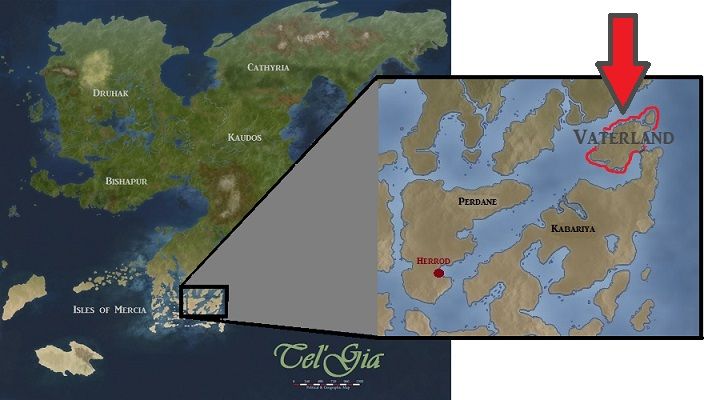Perdane
Isles of Mercia - Perdane - Kingdom of Perdane
Perdane is geographically the second-largest island in the Isles of Mercia (the largest being Kabariya, their eastern neighbor) and is predominantly human. For most of history, Perdane was made up of numerous small kingdoms that constantly fought with eachother for every possible reason. However, around two hundred years ago, the island was finally conquered by a
King Andayne II, who claimed he was descendant from the legendary hero
Andor Tucehaes. For the first time, the entire island was unified as a single nation, the
Kingdom of Perdane.
The eight kingdoms conquered by King Andayne II were re-established as
eight duchies, or states, and a
Duke or Duchess was selected to rule over the affairs of each. Appointed by the King, the most prominent noble family in the region was usually selected. The capital of Perdane,
Deon's Rise (named after the King's infant son Deon), was built on
Solpras Pennisula along the eastern coast, and the landmass was declared neutral, i.e. not a part of any province. (see Map of Perdane, marked by a white star)
For one hundred years, the Kingdom of Perdane did well, ruled after King Andayne II by his son,
King Deon I and his descendants. However, over the century, the King's power had
gradually declined, falling into the hands of greedy Lords and politically-minded noble families. Eventually, the states began to fight with eachother once more, unable to be controlled by the King. In their political confrontations, they started the practice of employing
pirates.
Pirates had always been a problem for the Isles of Mercia, especially Perdane, but for the most part, they were usually a disorganized and small group of criminals. Offered lucrative sums of money, power-hungry Dukes hired them to harass the ships of rival provinces; they were also employed as spies and troublemakers. Within a few decades, fueled by this new wealth, the pirates became
organized and increasingly intelligent, having become very intimate with island politics. Using their naval strength, they developed a tight grip on oversea trade and enacted heavy fees, augmenting their financial gains.
To the surprise of most historians, the pirates then used their new wealth wisely, investing in businesses and purchasing the loyalty of politicians. Over a couple more decades, their financial skill escalated drastically, claiming a vast economic control over the island. In contrast, the fighting between Lords had drained much government wealth, accumulating large deficits; ultimately, they were forced to take massive loans from the pirates.
Before long, the pirates gained control of the armies, responsible for much of their wages and income of many high-ranking officers. The King had long lost the power to interfere, and the various duchies became financially undermined by the pirate organizations. Finally, around fifty years ago, the first pirate leader declared himself a
Pirate Lord and assumed control of a province; the existing Duke had no choice but to submit, for the pirates even controlled his castle guards. The other seven provinces quickly succumbed to the same fate as a Pirate Lord claimed control of each.
In the capital of Deon's Rise, the eight Pirate Lords decided to occasionally meet as the
Council of Eight and manage national affairs, but for the most part, each Pirate Lord was left to individually rule over his own province. In many provinces however, the Pirates Lords decided to
keep the existing government, often to placate the people or because they didn't want to take responsibility for the daily affairs of governance. Instead, they changed only what they saw fit and left the rest to the existing Lord, who either made policy that satisfied the pirates or was quickly
replaced.
Up to the present day, Perdane is still under the control of Pirate Lords, who have dug deep financial roots into the isle's economy. Although
King Owendir I is the current official King of Perdane, his actions typically reflect decisions made by the Council of Eight; likewise, the official Dukes of each state are highly influenced by their corresponding Pirate Lord.
There is some speculation that politics are changing, and provinces are drifting from pirate control as the economies grow larger and more sophisticated. And despite occasionally meeting as the Council of Eight, Pirate Lords are not always on friendly terms with one another; consequently, there are often vendettas, skirmishes, and other conflicts of interest between them. Such observations give some hope that Perdane is leaving pirate control and entering a new political era, but this remains to be seen.
In sum, the
Kingdom of Perdane is a large nation characterized by complex and deep-rooted
politics rarely seen elsewhere in the Isles of Mercia. Ruled by a government of Kings & Dukes and a
shadow government of Pirate Lords, the island can be dangerous for those who interfere with the status quo. Tourists traveling to this destination are recommended to visit the
City of Herrod, which is said to be the largest known city in the isles and a must-go shopping destination!
This message was last edited by the GM at 13:06, Sun 21 Feb 2016.



























